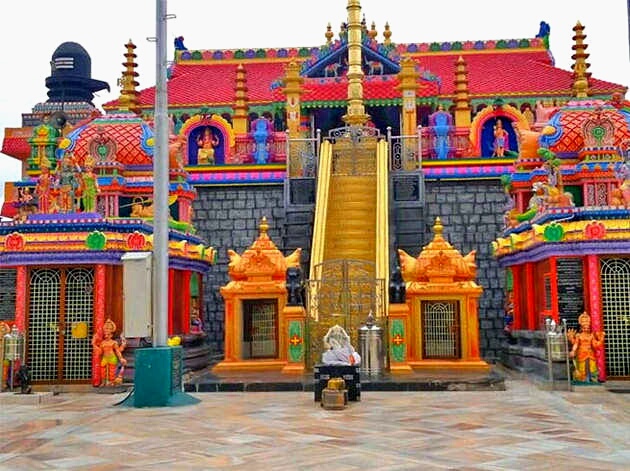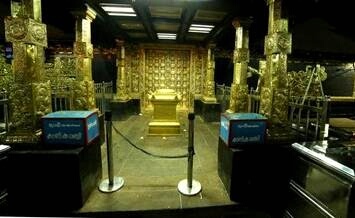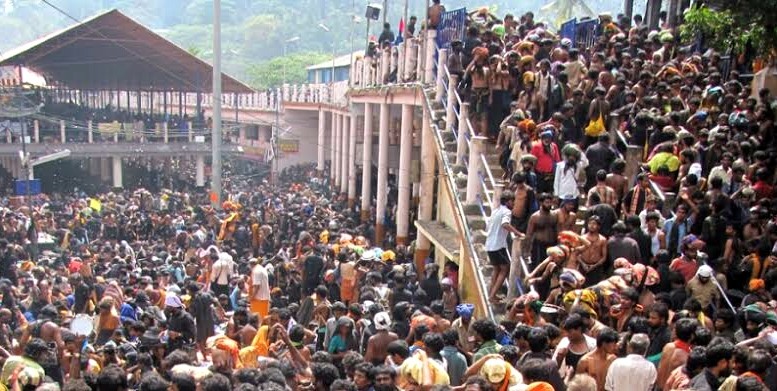
Sabrimala Ayyappan Temple
KERALA, 11 AUGUST, 2020 (GPN): The Sabarimala temple festival beginning November 16 will be held as per the COVID-19 protocol and pilgrim flow will be regulated through the virtual queue system, Devaswom Minister Kadakampally Surendran has said.
Addressing a meeting here on Monday to review the preparations for the festival, Mr.Surendran said the government’s attempt was to organise the pilgrimage within the limitations imposed by the virus spread. This would also impose a limit on the number of pilgrims to be permitted to the temple during the festival season.
Pilgrims reaching Sabarimala with COVID negative certificate would have to register their names on the portal and they would be permitted for ‘darshan’ without rush at the Sannidhanam.
The sand deposited in the Pampa river following the flood in 2018 had been moved to the parking ground at Chakkupalam, the Pathanamthitta district administration told the meeting. Floods during the past two days might have again brought sand to the river, the district administration officials told the meeting.
Steps had been taken to manage natural disasters and the Disaster Management Authority had been told to set up an emergency operation centre at Pathanamthitta. The District Disaster Management Authority and the district administration demanded helicopter service facility for emergency evacuation.
It was decided that agencies such as Consumerfed would be engaged to meet the needs of pilgrims if traders refused to join shop auction. Accommodation facilities would be provided for KSRTC staff and other employees on daily wages.
Kerala Water Authority personnel said drinking water and toilet facilities would be provided for pilgrims without any hitch. All road works would be completed ahead of the pilgrimage.
Ranni and Perinad grama panchayats that come in the pilgrimage zone were told to enforce a ban on plastic. Member of the erstwhile royal family of Pandalam Sasikumara Varma demanded that the work on the resting centre at Pandalam should be completed at the earliest. The Minister directed the board president to take action on the demand of Mr.Varma.
Travancore Devaswom Board president N.Vasu said the board was ready to conduct the pilgrimage as per the COVID-19 protocol. He wanted the district administration to vacate the buildings of the board that were being used as COVID treatment centres before the festival. ENDS

Gold Sanctrum Sabrimala Ayappa Temple
IMPORTANT NOTE:
THE HISTORY OF LORD AYAPPA
At this juncture, it is important to understand that there are many other Ayyappa temples in India, where Lord Ayyappa is worshipped in many forms but here we will understand the story of Lord Ayyappa of Sabarimala in short. More information is available here.
According to History, Lord Ayyappa has his human incarnation as the son of Raja Rajasekhara, the King of Pandalam, Kerala. His name was Manikantan (Mani – gemstone, Kantan – wearer around the neck). The King got him on the banks of river Pampa, adopted him as their son and accepted him as the prince (Yuvaraja) by them.
Once Manikantan killed a demoness Mahishi and then a beautiful young lady appeared. She was cursed to become Mahishi. After coming out of the curse she wanted to marry him.
But since he has taken eternal Brahmacharya (called Naishitika Brahmacharya) he could not marry her but promised to marry her when new pilgrims stop coming to him. He told the King about the process of his worship and the results his worshippers would get (Bhutanatha Upakhanyam). Accordingly, the king constructed the temple and next to that another temple was constructed for the Devi, who is now worshipped as Maalikapurathamma.
Austerity To Be Observed by the Ayyappans
At this point, we also need to understand the process of deity worship at Sabarimala. The essential part of deity worship at Sabarimala is keeping penance for at least 41 days before coming to the temple. The penance includes but not limited to simple living, absolute cleanliness and holy thoughts. Since the deity is a celibate, these pilgrims need to maintain absolute celibacy for these 41 days. The devotee needs to maintain the absolute purity of his body and mind during this time. Total abstinence from all vices like alcohol, tobacco, non-vegetarian food is a must. Personal adornments, hair cutting, shaving etc. is also not permitted.
The process of keeping penance is of paramount importance here. One needs to achieve high levels of purity of the body and mind before one can go for the Darshan.
Cleanliness of Body and Mind
It is important to understand that in Hinduism it is absolutely important to be clean both from inner self and outer self before any deity worship. Even men, who are not properly clean cannot perform deity worship. That is why in public places of worship like temples, not every man visiting there has the ‘right’ to touch the deity. The reason Brahmins follow a certain lifestyle and follow certain procedures before any deity worship is this.
Why Procreating Women Are Not Allowed
The popular belief that menstruating women are unclean (because menstruation can happen anytime) and hence are not allowed into the shrine may not be true. One argument being, there is a alight chance that women below 10 and more than 50 may also have a chance of menstruation bleeding. Actually, this is what is presented during the court arguments as well. So, it is important to understand that this age bar was placed by the Kerala Govt. by an ordinance and even the respondents of the Sabarimala PIL feel it was arbitrary and it should have been based on procreation ability of women. But the question is how can you even check if one woman has procreating ability without setting an age limit is a question.
Celibate Nature of the God
The most popular belief for the ban of women is more to maintain the celibate nature of God. As one of the prominent rules of performing Naishitika Brahmacharya is to keep as much distance possible from women. Even Sr’la Prabhupada during his Sannyasa life used to keep maximum distance from women, he even stopped meeting his own sister alone. The level of stricture for a God is to be observed at a higher level.
But the question is, if he has attained the status of a God, then how is he perturbed by the presence of procreating women? And why only he is disturbed by procreating women and not women who are younger or older in age?
This question becomes stronger when we know it was the Kerala Govt. and not the Hindu scriptures that have set the age limit. Advct. J Sai Deepak, who argued in favor of the respondents in the SC PIL said in an interview that the Tantra Philosophy puts enormous importance to the sexual energy and hence only procreating women are banned from entry. There comes the argument of the choice of Lord Ayyappa, too. His choice of observing his celibacy as found in scriptures of the temple was that he wanted to keep a distance from women. So, if that was the choice, then why any woman is allowed to enter into the temple?
Since we now know that this age group was specified by the Kerala Govt. by an ordinance, there seems to be a high chance that it was more to safeguard itself from the constitutional provision of equality. But unfortunately, this is challenged again on the same ground.
So, we understand that if the celibate nature of the God Ayyappa was the main concern then all women should have been barred, but it is not so. Why?
Respect For Maalikapurathamma
Some people say, women voluntarily don’t enter the temple to show respect for Maalikapurathamma who is waiting outside the temple to marry Lord Ayyappa once new devotees stop coming to him. However, with some women still going to meet Lord Ayyappa, this argument also seems partly valid.
Why The Head Priest said What He Said
Now if you read the arguments above, you will know none of the above explanations actually can explain allowing entry to a certain group of women and banning entry for some others. When the Lord Ayyappa wanted to apply more strictures upon him, why should any woman be allowed? Here the reason given by the head priest of the temple comes into focus.
Not only the head priest, but there are other Hindu sages said, that if procreating women are allowed to enter Sabarimala Ayyappa temple, then “it will harm them.” But their voices are not heard very often or get suppressed by the popular theory that “menstruating women” are not allowed, which is not true.
So, to understand the nature of the harm it can cause to women I spoke with some Hindu Gurus. From those discussions, what I understood is this –
Tantrik forms of Temples have enormous energy inside. Since this deity is eternal Brahmachari, the energies inside the sanctum are enormous, when Ayyappans pay a visit to the god, their energy also gets a part of it. This collective energy can be so huge that it not only harms women with childbearing capability, this energy may also impregnate them. But even to accommodate this energy within, women will need tremendous yogic powers, else this will harm them for good.
There are many stories in Hindu Puranas where women just offered prayers to their god for a child and gave birth to children. Hindu Shashtras had many such instances. Kunti and Madri both gave birth to children by a boon given to them. Karna was also born from the grace of the God Sun. So, we understand that Hindu mythology has many such examples of children taking birth with any intercourse.
Since fertile women will be in the mood of procreating, that is the time when their body will be more conducive to procreation. They will attract this energy towards them which will result in what the head priest just hinted that led to controversy. This will also reduce the overall energy of the place and hence will affect all pilgrims as they will not get their desired results.
What Some Others Say
Some other gurus however say a different thing. They say, what the head Tantri has said has literal meaning than theological one. They said, a temple is not a tourist spot and it is for bhakti. We need to essentially leave our material desires behind and enter the temple. There are other temples where the temples see lovers making love inside the temple and in the compund. There are instances where new brothels came up around ISKCON temple in Kolkata. They say, we need to maintain sanctity of temples, else they will become lovemaking places and the desired outcome of spritual advancement not possible.
How The Energy Can Harm Women
At this juncture, it is important to understand how the energy generated from the Sadhana can actually harm women.
If you remember the rules of penance I discussed earlier, before coming to Sabarimala, every devotee must observe complete abstinence and reorient that sexual energy to raise the spiritual energy. In both men and women, our sexual energy flows downwards, and spiritual energy flows upwards. For men, celibacy can improve and store this energy in their body. In men, the energy flows in the form of semen and in women in the form of menstrual flow. The flow of semen can be controlled but not the flow of menstrual blood. So, when men observe penance and Brahmacharya, their sexual energy enhances. They can store this energy in their body. That is why Brahmachari men have better sexual powers as they can control their sexual power well. So, Brahmacharya is actually beneficial for men.
On the other hand, women have a natural monthly cycle of downward flow of blood out of their body. This is the natural process of eliminating the old blood and refilling their body with fresh blood. If this natural process is disrupted by forcing their energy upwards, their downward menstruating flow will disrupt.
The spiritual energy (read ‘Teja’) in the temple is so much that normal women will not be able to endure it. Also, since one needs to visit the temple every year for 18 years, repeatedly practicing Brahmacharya (or any yoga in an inverted position that pulls their energy towards their head) they may lose their potency permanently. If women lose their potency, then life will come to a standstill. This is the real reason women are not allowed in the temple.
What Women Have Experienced
At this point it is important to discuss why women from the neighborhood of Sabarimala temple always avoided going to the temple before the ban. Sinu Joseph, who is a renowned menstrual hygeine educator from Mythri, a feminist NGO discussed real experiences of women in temples and how different temples have altered women’s menstruation cycles.
As always, some atheist and non-believer Hindus who are non-Ayyappa devotees are discussing the issue of the right to pray in public places. However, we need to understand that this temple is not run by the state to implement any of the rights discussed. It is learnt that the annual funds (51 lakhs) it receives through the Kerala Govt, is actually the rent paid to the temple by the Union of India. The history, in short, is when the Travancore Princely states joined the Indian Union in the year 1922 that was the time it was decided. So, the state or Indian Union can’t interfere into the religious matters there. So, no rights can be implemented by the Union of India. The sole right that should prevail in the temple is that the right of Lord Ayyappa, as this is His house.
Why Ban Entry? Why Not Let Women Decide?
Another question that is frequently asked is why ban women’s entry into Sabarimala temple? Why not leave entry to women’s choice?
One strong point against leaving it women’s choice is when women of reproducing capability enter the temple and absorb the energy in them, they reduce the overall energy that can benefit of other devotees. This way, other devotees will not get their desired result.
There is another point that we can’t leave such decisions on people who are ignorant about ill-effects. Only the people who are knowledgeable about the subject has the right to decide. Other ignorant people may end up harming them more because of their ignorance rather than anything else. Also, as a society we have the responsibility to ensure that every social ritual have a social welfare attached to it. As Hindu Shashtras promote saving women for saving humanity (because of their reproductive power), anything which follows shashtra can’t be done to the contrary.
NOTE: Paradox of ’33-Koti’ Hindu Gods
Very often we Hindus think ’33-Koti’ means 33 Crore or 330 Million. Even I used to think the same until recently. But that is not true. After my discussions I came to know ’33-Koti’ in Sanskrit language does not translate to 33-crore in English. Rather the explanation is given below –
33-koti-hindu-god
33-Koti Hindu Gods are often Misinterpreted as 33-crore Hindu Gods. Explanation is given below
These 33-परमपूज्य or highly respected gods are –
8-Vasu, 11-Rudra, and 12-Aaditya, 1-Indra and 1-Prajaapati. (In some Hindu Purana instead of Indra and Prajapati, Ashwinikumardway is mentioned.
8 Vasus are ~ Air, Ether, Moon, Earth, Water, Fire, Sun, and Star.
They are called Vasus, because they are abode of all that lives, moves or exists. (also mentioned in Mahabharat, 1/66/18)
11 Rudras ~ First ten Pranas (Praana, Apaana, Kurma, Krikal, Devadutta, Vyaana, Samaana, Udaana, Naag and Dhananjaya) i.e. nervauric forces which live in the human body.
Human soul is the the eleventh one. These are called ‘Rudras’ because when they desert the body, it becomes dead and the relationships of the deceased, consequently, begin to weep. (Rudra means one who makes a person to weep)
12 Adityaas —the twelve months of a year called Adityaas, they cause the lapse of the term of existence of each object or being.
1. Indra which is also known as the (all-pervading) electricity, as it is productive of great force.
1. Prajaapati , also called the “Yajna” because it benefits mankind by the purification of air, water, rain and vegetables and because it aids the development of various arts, and in it the honor is accorded to the learned and the wise.
*Some say this as only 33-types of Hindu God. However, only mention of ‘types’ make it disrespectful for a God. So, परमपूज्य is mentioned. You can worship any other (like we Hindus really don’t have any dearth of god, but the creator of the universe is one. So, Hindus also believe in one God.
CONCLUSION:
It is important to understand that there is no society or system where everyone can have absolute equality in all spheres. This is certainly not enforceable in matters of religion. Also, Hindus need to understand that Hinduism is so vast that we hardly know this religion properly. If Hinduism survived the test of time, that is because of its inherent potentials. If you are a Hindu, respect your religion, else no one else will. Once, we Hindus lose our culture in the name of liberalism and fake equality, then we will lose our identity.
In the case of Sabarimala Ayyappa, as you understand, mindless equality can actually harm Hindu women and take away their reproductive ability. Don’t even fall for such feminist traps. ENDS


Be the first to comment on "Sabarimala pilgrimage will be held as usual in adherence to COVID protocol Covid with mandatory Covid Negative Certificate for pilgrims"